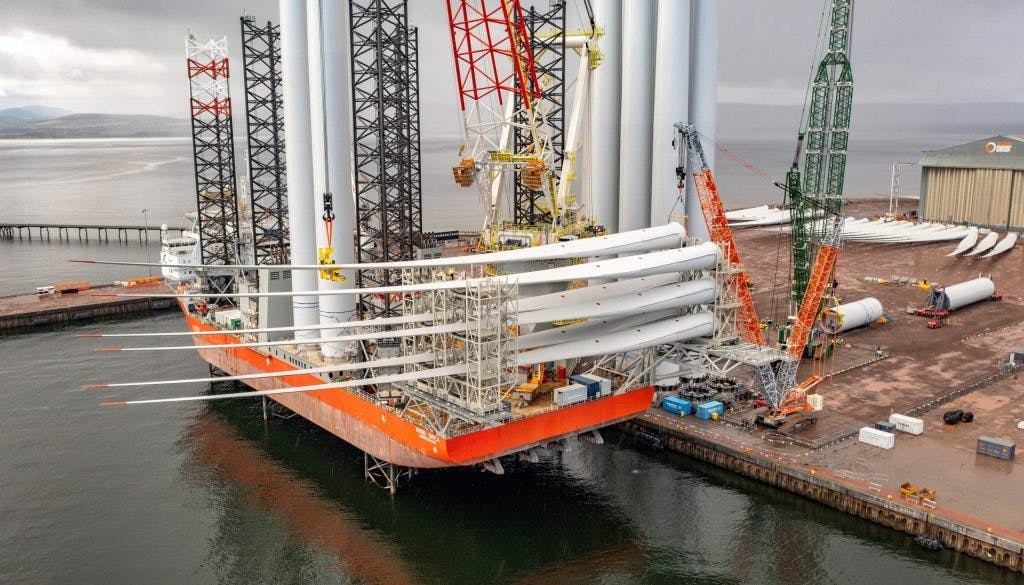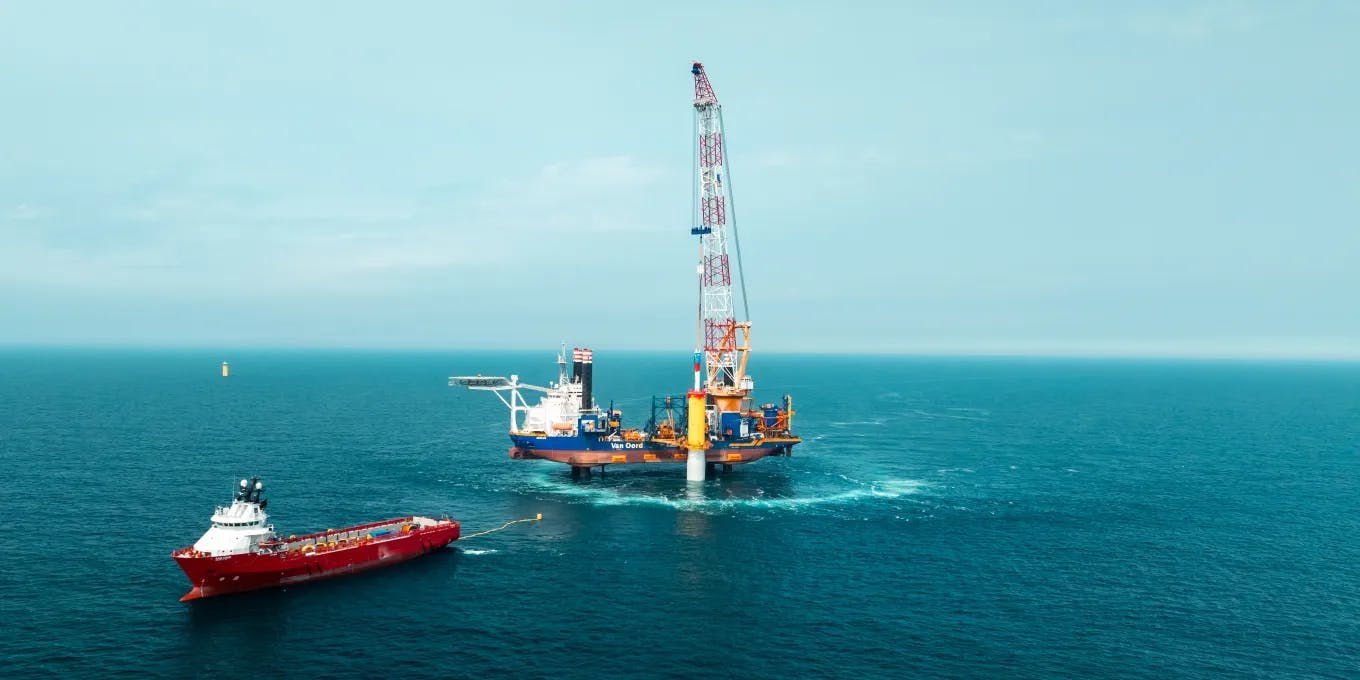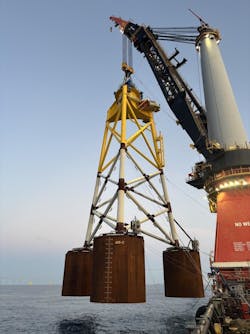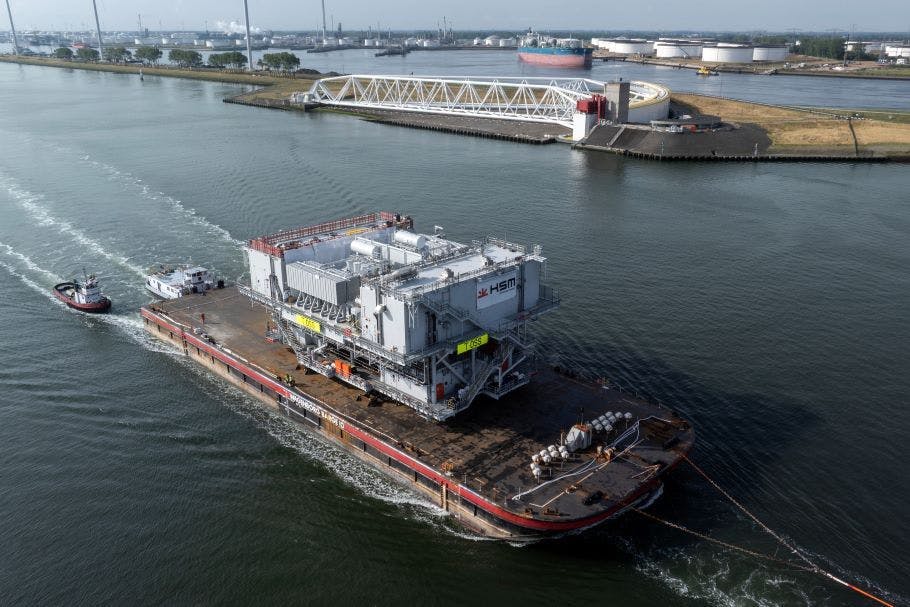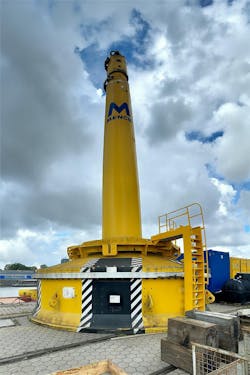Roundup: Offshore wind energy projects continued making progress in July
Siemens Gamesa provisionally selected for Baltic Sea BC-Wind turbines
Ocean Winds (OW), the 50:50 joint venture between EDP Renewables and ENGIE, has chosen Siemens Gamesa to supply and maintain the offshore wind turbines for the BC-Wind project in the Polish sector of the Baltic Sea, according to a July 29 OW news release.
Subject to a Notice to Proceed by the co-venturers, Siemens Gamesa will provide 26 SG 14-236 turbines for the Phase I development. All the turbines will have a nominal capacity of 14 MW, with a Power Boost feature designed to increase power output to 15 MW.
Last summer, the turbines received IECRE type certification, confirming compliance with international quality and safety standards, OW added. They are due to be installed and commissioned in 2028, with BC-Wind entering service the same year.
The project’s marshalling harbor will be Terminal T5 in the Port of Gdańsk, serving as the logistics base for pre-assembly and load-out operations.
BC-Wind will be located 23 km north of the coastal Krokowa and Choczewo municipalities in the Pomeranian Voivodeship. It will have a planned capacity of up to 390 MW, with the development spread across a total area of 90.94 sq km.
The project has secured an environmental decision for the offshore and onshore components, and rights to a Contract for Difference. OW is now focused on appointing the remaining major suppliers, with FID planned later in the year.
MODEC develops rapid assembly FoW concept
ABS has issued an approval in principle (AiP) to MODEC for its floating offshore wind turbine concept iTLP2-FOWT (i-TLP2), according to a July 31 company news release.
MODEC said the development forms part of its initiative to provide novel offshore wind turbine solutions that deliver electricity at a low levelized cost of energy (LCOE).
In addition, the focus with i-TLP2 has been on the use of already available turbines; maximizing power output from limited wind farm areas; fast, large-scale deliveries followed by quick installation on the seabed and operational service.
Bottom-fixed offshore wind turbines are typically installed in water depths of up to 50 m. While various concepts are under consideration for floating offshore wind turbines in deeper water, such as semisubmersibles and spars, these tend to require a catenary mooring.
In turn, this means the turbines must be able to withstand large wave-induced motions, with a large footprint for each unit, MODEC claimed.
However, the TLP-oriented features of the i-TLP2 are said to minimize floater motions and seafloor footprints. The design also has several improvements compared with the first-generation MODEC TLP, which should enable rapid construction and turbine integration at land-based locations, along with in-situ offshore heavy-duty maintenance of the turbines post-installation.
CTO Koichi Matsumiya said the company was now seeking partners “to help us demonstrate our concept through practical applications."
MODEC is also working on a bottom-fixed wind turbine platform concept that would be suited to installation in up to 100 m water depth.
Van Oord progressing work on Sofia, Windanker wind farms
Van Oord’s construction vessel Aeolus has installed all the monopile foundations at the 1.4-GW RWE Sofia wind farm on Dogger Bank in the central UK North Sea, according to a July 15 company news release.
The company’s full EPCI workscope covers the wind turbine generator foundations and installation/burial of about 360 km of subsea array cables, which should be completed during the current quarter.
Sofia, owned 100% by RWE, is due to be operational in 2026.
In June, Van Oord's newest offshore wind installation vessel Boreas underwent a naming ceremony in Rotterdam. It is designed for transportation and installation of next-generation foundations and wind turbines.
The vessel is 175 m long, and it features a crane with a 155-m high boom, capable of lifting loads of more than 3,000 tonnes, including wind turbines of more than 20 MW.
In addition. in the German sector of the Baltic Sea, Van Oord has commissioned SPIE Wind Connect to perform termination and testing of 21 6-6kV inter-array cables at the 315-MW Windanker offshore wind farm.
Work on the project is set to start during the fall, followed by completion next spring with termination/testing of the final inter-array cables connecting the wind turbine generators with the offshore substation.
Suction pumps deployed for Greater Changhua jacket foundations
Offshore Taiwan, all 66 suction-bucket jacket (SBJ) foundations have been installed for Ørsted’s Greater Changhua 2b and 4 wind farms.
Norway-based Framo supplied and operated its proprietary suction pump spread systems to help secure the jacket foundations to the seabed, according to a July 16 company press release. The systems, manufactured in Flatøy, are said to eliminate the need for conventional pile driving.
The two wind farms, with combined generating output of 920 MW, are 35-60 km from the coast of Changhua County.
Framo’s offshore team worked with specialists from the Norwegian Geotechnical Institute, which provided instrumentation, monitoring and technical support.
Heerema’s heavy-lift vessel Aegir installed the jacket foundations, setting each structure on the seabed before Framo’s suction pumps secured them.
GHD leading EIA for Blue Mackerel project
In the Gippsland Basin offshore Victoria, Australia, GHD will lead the environmental impact assessment (EIA) and approvals process for the planned 1-GW Blue Mackerel wind project developed by Parkwind, according to a July 16 GHD press release.
The development could be in operation by 2032-33.
Parkwind is part of JERA Nex, JERA’s renewable energy subsidiary.
Thor wind farm substation departs HSM yard
HSM Offshore Energy has completed construction of the jacket and topside for the high-voltage substation for the 1.1-GW Thor wind farm in the Danish North Sea, according to a July 17 press release.
Both have departed the company’s yard in Schiedam for the offshore destination, 22 km from the west coast of Jutland. Thor, Denmark’s largest offshore wind development, is a joint venture between RWE (51%) and Norges Bank Investment Management (49%).
The substation will collect and transform electricity generated by 72 offshore wind turbines, subsequently transmitted to the onshore grid at Volder Søndervang.
HSM was awarded the engineering, procurement, construction, installation and commissioning contract in 2022, including high-voltage equipment for the topside and the jacket foundation.
The topside—39 m long with a breadth of 36 m and a height of 18 m—weighs about 2,600 metric tons. The jacket is 40 x 40 x 50 m with a weight approaching 2,500 mt.
According to HSM, the compact substation has one of the offshore wind industry’s best power-to-weight ratios and could open to path to more widespread smaller and lighter offshore substations in future.
Skyborn secures Gennaker offshore wind turbines agreement
In Germany, Skyborn Renewables has executed supply and offshore long-term service agreements for the Gennaker wind farm in the German sector of the Baltic Sea covering 63 x SG 14-236 wind turbines, according to a July 17 company news release.
Installation offshore should start early in 2028.
Gennaker, with a capacity of up to 976.5 MW, will become the largest offshore wind farm in the German sector of the sea, Skyborn added.
The location is 15 km north of the Fischland-Darß-Zingst peninsula, within a priority zone for offshore wind energy in the Mecklenburg-Western Pomerania coastal sea.
Acteon to install piles for North Sea Hornsea 3 turbine foundations
Acteon’s Marine Foundations business will provide pile-driving equipment and operations to support construction of Ørsted’s 2.9-GW Hornsea 3 wind farm development in the UK southern North Sea, according to a July 24 company news release.
The location is 160 km from the Yorkshire coast and 120 km from the Norfolk coast to the south.
For the campaign, Acteon will deploy a MENCK MHU4400S submersible hydraulic hammer and associated pile sleeve and anvil, designed for monopiles of up to 11 m in diameter.
The MHU4400S is designed to drive both large monopiles and smaller-diameter piles for offshore wind installations.
Additional offshore wind news from July 2025:
About the Author
Jeremy Beckman
Editor, Europe
Jeremy Beckman has been Editor Europe, Offshore since 1992. Prior to joining Offshore he was a freelance journalist for eight years, working for a variety of electronics, computing and scientific journals in the UK. He regularly writes news columns on trends and events both in the NW Europe offshore region and globally. He also writes features on developments and technology in exploration and production.

